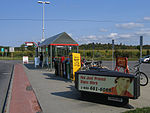Earl of March Secondary School
1971 establishments in OntarioEducational institutions established in 1971French immersion schools in CanadaHigh schools in OttawaMiddle schools in Ottawa ... and 1 more
Pages with non-numeric formatnum arguments
Earl of March Secondary School is an Ottawa-Carleton District School Board secondary school in Ottawa, Ontario, Canada. It is located in suburban Kanata in the Beaverbrook neighbourhood near the Ottawa Public Library Beaverbrook Branch and the John G. Mlacak Centre. The school also serves the neighbourhoods of Kanata Lakes, Beaverbrook, Katimavik-Hazeldean, Richardson Ridge, and Morgan's Grant.
Excerpt from the Wikipedia article Earl of March Secondary School (License: CC BY-SA 3.0, Authors).Earl of March Secondary School
The Parkway, Ottawa Kanata
Geographical coordinates (GPS) Address Phone number External links Nearby Places Show on map
Geographical coordinates (GPS)
| Latitude | Longitude |
|---|---|
| N 45.3232 ° | E -75.8951 ° |
Address
Earl of March Secondary School
The Parkway 4
K2K 1Y4 Ottawa, Kanata
Ontario, Canada
Open on Google Maps





